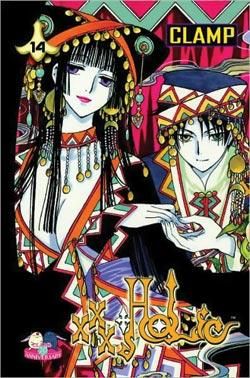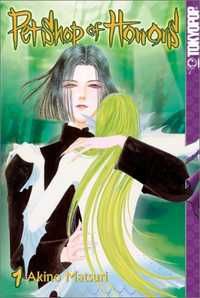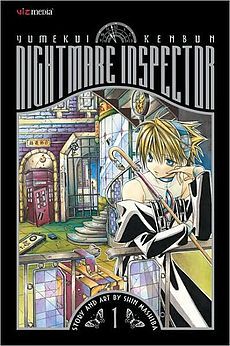There's a genre one sees quite a bit of in manga that seem to appear rarely elsewhere - the magic shop story. These are usually very similar, with a proprietor or a set of characters that runs a shop full of magical items that are vended to unsuspecting patrons, often with ironic results. It's a good framing device for series of unconnected short stories, usually horror-themed, and a kind of analogue to the horror collections that used to appear often among US comics. The US horror collections and these "magic shop" series are quite different, however. I'm going to cover the most popular "magic shop" series in this column, but there are so many that the topic will come up at least one more time. Also interesting is that the "flavor" of the series is often determined by the shop owner and characters - there is always an overarching plot and direction for the series, and all three of these are radically different, despite being horror-flavored collections of short stories united with a framing device.
xxxHolic - CLAMP (19 volumes)
Later, Holic becomes more about its main characters, but it always stays within its magical shop confines. Stories about the fates of the customers that come into the mysterious shop make up the majority of the series. Main character Watanuki wanders into the shop one day while fleeing spirits that nobody else can see. The shop winds up being a place that you can only enter if you need to. Proprietress Yuko promises to make the spirits disappear if he'll work for her. How long, she can't say. Payment in her shop is determined by hitsuzen, a kind of pre-determined fate that is a prominent theme in the series. So Watanuki works in the shop, mostly as a chef and errand boy. Yuko and Watanuki help clients with a variety of magic items, things that sometimes both Yuko and Watanuki have to venture out to get. The tone of the stories ranges from humorous to dark, and the series is quite good at balancing the different types. The stories all are heavily supernatural, though. Often Yuko and Watanuki are paid with some other magical artifact, and Yuko always assures Watanuki it is fair payment, no matter how useless the object may seem. Seemingly useless objects will have a use later in the series for some other client, or Watanuki himself. Watanuki also becomes increasingly entangled with the lives of the various mythological creatures, both benign and malevolent, that pass through the shop. The beginning of the series is quite good, and the short stories that build up the mythology of the series are paced well and always a lot of fun. But when the stories become more character-focused about halfway through the run, things start to drag. Specifically, we find that Watanuki's fate is entangled with the main character from another CLAMP series, which is almost not explained within xxxHolic itself. You are meant to read the full explanation in Tsubasa: Reservoir Chronicle, but I read said explanation three times, and I can't say it makes much sense. Sadly, though the episodic stories resume toward the end of the series, they're never quite as good. The early volumes are among the best that popular manga group CLAMP has penned, however, and both the art and storytelling are quite compelling. All 18 volumes of the series should be in print and available.
Pet Shop of Horrors - Matsuri Akino (10 volumes)
One of the more famous "Shop of Horror"-type series, and one that spawned many imitators. This series is set in San Francisco, and features Count D and his exotic pet shop. His path frequently crosses with Detective Leon Orcot, a homicide investigator who often traces violent deaths back to the suspicious Count D. Detective Orcot isn't wrong, as Count D's animals frequently do kill patrons, but their mysterious nature makes it difficult to pin wrongdoing on the Count. The one-shot stories follow the lives of many different types of people, from greedy to lonely to spoiled. The pets that Count D offer them are fictitious, and Akino does a wonderful job at designing different types of animals and costumes based on dancing, classic paintings, et cetera. There are different types of stories. Sometimes sad, sometimes violent, and sometimes the pet and human were meant to be together. To most people, the pets look like a person (the pet adoption often looks like the adoption of a child), and the pet shop looks like a tiny ramshackle storefront, though some can see their special qualities. The one-shot stories continue through much of the run, but D and Leon grow closer and become friends, and the rather cosmic climax of the series has to do with a violent betrayal and the mysterious origins of Count D. It's one of the modern classics of horror manga written for girls, and with its variety of gothic stories and Akino's beautiful art, it makes for a wonderful read. It has been out of print for some time, but I believe it was reprinted at least a few times, and there are many volumes available that keep used prices reasonable. There is a sequel series called Pet Shop of Horrors: Tokyo that was partially translated into English.
Nightmare Inspector - Shin Mashiba (9 volumes)
Admittedly, the popularity drops off precipitously here, as this series flew under the radar of most. But it was published by SquareEnix in Japan, who seem to be good with action-oriented series with a slightly unusual flavor, and I was quite fond of what I read of it, so it was the best for a third candidate. The shop in this series is a place people come to be cured of their nightmares, and the proprietor, Hiruko, is a Baku. A Baku is a type of legendary Japanese creature that eats dreams. Technically, he isn't vending wares, but his cures have real-world repercussions, so it's the same type of story. The volumes tend to have several stories each. An example of a Nightmare Inspector story is as follows: A young woman comes into the shop to be cured of her nightmare by Hiruko. She is trapped in the dark, and is held back from going forward by a rope. Hiruko tells her she's in a circular hallway, and it's her brother that's holding her back. His constant need for attention is making the woman feel like she can't live her life as she wishes, and Hiruko tells her that her subconscious is telling her to leave her brother. Her brother enters the shop a few days later, and we learn that the woman committed suicide, and that the brother's constant need for attention was an attempt to give the woman's life purpose, as she felt she had none. Being told to make a decision about leaving her brother, she found her life meaningless and killed herself. The stories are fairly well-constructed without relying overly much on standard plot devices, and they don't suffer from being rushed or incomplete, which is one of my frequent pet peeves in manga short stories. There's a bit of overarching plot, mostly involving a rival Baku that induces nightmares in his customers so that they taste better to him, which Hiruko views as unethical. The art is quite good, with a lot of very heavy gothic ornamentation that suits the dark mood of the series well. And at 9 volumes, it makes for a fun and not overly long read, especially since it's easy to pick up any volume and start. Most volumes of it are still available new online, though it's been complete for several years, so they may start to disappear shortly.




